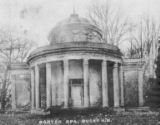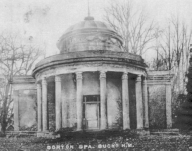
Dorton Spa
Encyclopedia

Dorton Spa is a Chalybeate
Chalybeate
Chalybeate waters, also known as ferruginous waters, are mineral spring waters containing salts of iron.-Name:The word "chalybeate" is derived from the Latin word for steel, "chalybs", which follows from the Greek word "khalups"...
spring located between the villages of Dorton
Dorton
Dorton is a village and civil parish in the Aylesbury Vale district of Buckinghamshire. It is in the western part of the county, about north of the Oxfordshire market town of Thame.-Manor:...
and Brill
Brill
Brill is a village and civil parish in Aylesbury Vale district in Buckinghamshire, England, close to the boundary with Oxfordshire. It is about north-west of Long Crendon and south-east of Bicester...
in Buckinghamshire
Buckinghamshire
Buckinghamshire is a ceremonial and non-metropolitan home county in South East England. The county town is Aylesbury, the largest town in the ceremonial county is Milton Keynes and largest town in the non-metropolitan county is High Wycombe....
, England
England
England is a country that is part of the United Kingdom. It shares land borders with Scotland to the north and Wales to the west; the Irish Sea is to the north west, the Celtic Sea to the south west, with the North Sea to the east and the English Channel to the south separating it from continental...
in a wood called Spa Wood. Chalybeate is defined as "a water or other liquor containing iron", the word's origin is Greek chalyps; chalybos, meaning steel; Chalyps being an ancient nation in Pontus
Pontus
Pontus or Pontos is a historical Greek designation for a region on the southern coast of the Black Sea, located in modern-day northeastern Turkey. The name was applied to the coastal region in antiquity by the Greeks who colonized the area, and derived from the Greek name of the Black Sea: Πόντος...
famous for its steel. A nineteenth century Chemical Dictionary describes the Dorton Spa as the most celebrated Chalybeate and from the account "there is nothing in England to compete with it, which is nearly four times as strongly impregnated with iron as Tunbridge
Royal Tunbridge Wells
Royal Tunbridge Wells is a town in west Kent, England, about south-east of central London by road, by rail. The town is close to the border of the county of East Sussex...
waters and almost as powerful as the famed waters of Toplitz, Germany".
The discolouration of the turf of Dorton by iron oxide and its iron water were generally known by local people for hundreds of years. Little was heard of its medicinal effects apart from some skin disorders that could be cured and the custom of washing mangy dogs and diseased cattle in the water. With meagre improvements in the roads in the late 17th century and increased communication, more people heard of the Dorton waters. The number of people visiting became so great that damage to crops and fences made it necessary to restrain the peasantry to one path and to regulate the supply of water. The well was enclosed and 50-100 gallons were disposed of daily at a fixed price.
The proprietor of the Dorton estate, Mr Ricketts of Dorton House, was anxious to give the public every facility of access to the water and he erected a pump room and baths of an extensive and ornamental manner. This handsome structure, modelled on Greek architecture, was entered by a flight of stone steps and through a semicircular portico supported by nine circular columns with Corinthian capitals. A dome rose above the centre; and the ceiling of the spacious and lofty pump-room was supported by eight columns painted to resemble Sienna marble. Twelve acres of park were laid out, and planted with a choice assortment of evergreen and deciduous shrubs, and also a serpentine lake covering an acre. A large opening ceremony took place in 1830. For a short period it gained some celebrity - Dorton Spa had become a fashionable resort. A Grand Fête was held in 1837; other efforts were made to bring the establishment before the public.
The fame of Dorton spread and stories of the effects of the waters grew. A man from Oxford
Oxford
The city of Oxford is the county town of Oxfordshire, England. The city, made prominent by its medieval university, has a population of just under 165,000, with 153,900 living within the district boundary. It lies about 50 miles north-west of London. The rivers Cherwell and Thames run through...
with leprosy for more than 20 years was cured by the water. A woman of Buckingham
Buckingham
Buckingham is a town situated in north Buckinghamshire, England, close to the borders of Northamptonshire and Oxfordshire. The town has a population of 11,572 ,...
, with scrofula was cured within six weeks. An elderly resident from Tetsworth
Tetsworth
Tetsworth is a village and civil parish about south of Thame in Oxfordshire.-Manor:At the time of the Domesday Book in 1086 Tetsworth did not exist as a separate manor. In the 12th century, benefactors gave land in the area to the Cistercian Thame Abbey and these lands were brought together as an...
unable to stir received great benefit in a case of a bleeding cancer could after treating with the water walked a considerable distance. Cures were also cited for hysteria, indigestion, bilious affections, worms, haemorrhages, rheumatism, fevers, ague, St Vitus's dance, dropsy, herpes, ulcers, abscesses, general nervous diseases, a host of skin disorders and even total blindness. A depot or agency office was opened in London for the sale of the water. The Ashmolean Museum
Ashmolean Museum
The Ashmolean Museum on Beaumont Street, Oxford, England, is the world's first university museum...
in Oxford has a label from a bottle of Dorton water. A book was written promoting the Spa by a surgeon Mr Thomas Knight then living in nearby Oakley, Buckinghamshire
Oakley, Buckinghamshire
Oakley is a village and civil parish in Aylesbury Vale district in Buckinghamshire, England of about 400 households with a population of 1,059 people and an area of...
.
Grandiose schemes were proposed showing ten separate baths, two ballrooms, a reading room and a billiard room. Whether all these schemes were completed is subject to conjecture. A hotel in Brill was also built, the Spa Hotel, overlooking the spa
Spa
The term spa is associated with water treatment which is also known as balneotherapy. Spa towns or spa resorts typically offer various health treatments. The belief in the curative powers of mineral waters goes back to prehistoric times. Such practices have been popular worldwide, but are...
to accommodate the visitors. (The hotel was pulled down after damage sustained by a German doodle-bug exploding nearby in World War II).
But in 1841 the new Queen Victoria did not come to Dorton. Because of Royal patronage Tunbridge Wells
Royal Tunbridge Wells
Royal Tunbridge Wells is a town in west Kent, England, about south-east of central London by road, by rail. The town is close to the border of the county of East Sussex...
became Royal Tunbridge Wells and Leamington Spa
Leamington Spa
Royal Leamington Spa, commonly known as Leamington Spa or Leamington or Leam to locals, is a spa town in central Warwickshire, England. Formerly known as Leamington Priors, its expansion began following the popularisation of the medicinal qualities of its water by Dr Kerr in 1784, and by Dr Lambe...
became Royal Leamington Spa. Dorton missed out, its isolated situation made it impossible to obtain popularity; the sanguine expectations of the promoters were not realised.
All that remains is a small circular built brick well building complete with a curved wooden door which is hidden within privately-owned "iron fenced" Spa Wood. Parts of the original columns can also be found within the wood.

